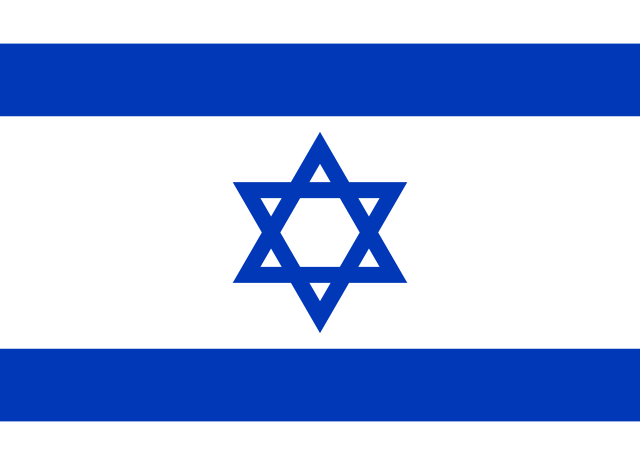Estado de Israel
SÍMBOLOS
Bandera
According to the Israeli government website, the flag of the State of Israel (דגל ישראל, Degel Yisra’el) is based on the design of the Jewish prayer shawl (tallit), with a blue Shield of David (Magen David).
The Knesset approved the Flag and Emblem Law (5709–1949), which made the blue and white flag of the Zionist movement and the emblem of the menorah, or seven-branched candelabrum, the official symbols of the State of Israel.

Normativa de uso
The Flag and Emblem Law enacted in May 1949 regulates the legal and political status of the flag and the emblem of the State of Israel.
No person shall use the State flag in any manner whatsoever for purposes of commerce, business or any trade, save under a license or permit from the Minister of the Interior; but the flying of the State flag or the manufacture of dealing in State flags shall not be deemed to be use of the State flag within the meaning of this subsection. A licence or permit issued under this Law may be general or to a particular person or class of persons, and the Minister of the Interior may impose therein such conditions and restrictions as he may think fit.
Escudo
The official emblem of the State of Israel (סמל מדינת ישראל, Sēmel Medīnat Yīsrāʾēl) was designed by the brothers Gabriel and Maxim Shamir and features a seven-branched candelabrum (menorah), whose shape is said to be derived from the seven-branched moriah, a plant known since antiquity. The olive branches on either side represent Israel’s yearning for peace. The word “Israel” connects the branches at the bottom

Normativa de uso
The Flag and Emblem Law enacted in May 1949 regulates the legal and political status of the flag and the emblem of the State of Israel.
No person shall manufacture any object bearing on it the State emblem, save under a license or permit from the Minister of the Interior. No person shall use the State emblem in any manner whatsoever, save under a licence or permit from the Minister of the Interior. A licence or permit issued under this Law may be general or to a particular person or class of persons, and the Minister of the Interior may impose therein such conditions and restrictions as he may think fit.
Himno
The text of Hatikvah, the Israeli national anthem, was written by the Jewish poet Naphtali Herz Imber in 1878. The anthem speaks of the hope of the Jewish people to live as a free and sovereign people in the Land of Israel.
The origins of the melody of “Hatikva” are uncertain. There has been a great deal of speculation over the years as to where it came from: an old Italian air, a Slavic shepherds’ song, a Polish tune. Some believe that the tune originates in the symphonic poem entitled “The Moldau” by Czech composer Bedřich Smetana. But it appears that Shmuel Cohen, who immigrated to Israel in 1888, is the one who set the lyrics of “Hatikva” to a Romanian folk tune.
Hatikva was naturally accepted as the national anthem, but only in 2004 it became the official anthem, when it was anchored in the Flag, Emblem, and National Anthem Law (1949).
Música y letra
כָּל עוֹד בִּלְבַב פְּנִימָה
נֶפֶשׁ יְהוּדִי הוֹמִיָּה
וּלְפַאֲתֵי מִזְרַח קָדִימָה
עַיִן לְצִיּוֹן צוֹפִיָּה
עוֹד לֹא עָבְדָה תִּקְוָתֵנוּ
הַתִּקְוָה בַּת שְׁנוֹת אֲלָפִים
לִהְיוֹת עַם חָפְשִׁי בְּאַרְצֵנוּ
אֶרֶץ צִיּוֹן וִירוּשָׁלַיִם
Una versión instrumental del himno nacional de Israel, con arreglos de Masataka Matsuo puede escucharse aquí.
Otros
The Menorah
Although it has been part of Jewish art for the past millennium, it was first used in the Tabernacle during the Israelites’ journey from Egypt and later in the Temple of Solomon. The menorah is central to archeological exhibits discovered in Israel and the Mediterranean region. The specific menorah that appears on the state emblem is a replica of the menorah from the Second Temple that appears on the Arch of Titus in Rome.
PRECEDENCIAS
Protocol of the State of Israel, מְדִינַת יִשְרָאֵל “Medinat Yisra´El”.
The Chief of Protocol of the Ministry of Foreign Affairs is also the Chief of Protocol of the State of Israel regarding the protocol and ceremonial aspects of its foreign relations.
Moreover, the Chief of Protocol heads the internal Foreign Ministry committee, which approves the acceptance of foreign honorary consular officers and the appointment of the Israeli honorary consular officers in foreign countries.
The Protocol Department handles all the procedures concerning accreditation of members of foreign Missions in Israel, accompanies them throughout their term of duty in Israel, and grants them the relevant assistance and services to enable them to carry out their functions.
As well, the Department takes care of inquiries deriving from the Vienna Conventions and the bilateral agreements which are related to working and living conditions of the members of foreign Missions in Israel.
Once a year (usually in January), the Department publishes the Diplomatic List based on information received from the Diplomatic Missions approximately one month before publication. The List includes:
- Diplomatic Agents having the rank, status, and title recognized by international conventions, who are substantially performing their functions, and who were formally accredited.
- The Order of Precedence of Heads of Missions which includes the date of presentation of their credentials.
- Calendar of National Days.
- List of honorary consular officers of States not represented in Israel by a resident diplomatic mission.
List of Senior Officials of the Ministry of Foreign Affairs: Issued once a year towards the end of the year.
List of the State Ceremonies which take place each year. The list is issued and distributed by the Protocol Department once a year, and the Heads of Mission or the Dean of the Diplomatic Corps (representing all the Missions) are invited to attend these ceremonies.
Dress code
During the daily work routine, a tie and jacket is acceptable; on more formal occasions – a dark suit. On occasions of a religious character, it is recommended that consideration be given to the respective customs of each religious community.
Official Ceremonies: The rules of ceremonial protocol
The Ministerial Committee for Ceremonies and Symbols is appointed by the Government of Israel to set the rules of ceremonial protocol for all authorities in the State of Israel. The protocol distinguishes between three types of visits: A state visit, an official visit, and a working visit. According to protocol, a state visit or state occasion require the performance of full ceremonial protocol.
The committee also lists the types of ceremonies, including:
- Ceremonies held during visits by heads of state
- A farewell ceremony upon the departure of the President of the State from the country, and a reception upon his return
- Memorial ceremonies for those who fell in Israel’s wars and casualties of hostile acts: a gathering at the Western Wall and a ceremony on Mount Herzl
- Ceremonies for Holocaust Martyrs’ and Heroes’ Remembrance Day: The official ceremony at Yad Vashem, the laying of wreaths at Yad Vashem, and the “Every Person Has a Name” ceremony that takes place in the Knesset
- Reception of diplomatic letters of credence from foreign ambassadors appointed by countries that hold diplomatic relations with Israel
- Memorial ceremonies for deceased Israeli presidents and prime ministers at the President’s Residence and at the cemeteries.
- Official reception for diplomats on Israel’s Independence Day
- Ceremonies honoring outstanding soldiers on Independence Day
- Ner Yitzhak (Yitzhak’s Candle), the official memorial ceremony for the late Prime Minister Yitzhak Rabin
ORDER OF PRECEDENCE FOR STATE EVENTS
Order of Precedence as Authorized on 25/2/08 for State Events
(Shortened Top VIP list).
- The President of the State of Israel.
- The Prime Minister.
- The Speaker of the Knesset.
- The President of the Supreme Court.
- The Chief Rabbis of Israel.
- The former Presidents of the State of Israel.
- The Government Ministers.
- The Head of the Coalition, the Head of the Opposition.
- Justices of the Supreme Court.
- The Legal Advisor to the Government, the State Comptroller, the Governor of the Bank of Israel.
- The Chairman of the Executive of the World Zionist Organization and the Jewish Agency for Israel.
- The Dean of the Diplomatic Corps.
- The Chief of Staff of the Israel Defense Forces, the Commissioner of Police.
- The Heads of the Religious Communities (non-Jewish).
- The Government Secretary.
- The Knesset Secretary.
- The Chief of Staff in the Prime Minister’s Officer.
- The Director General of the Prime Minister’s Office.
- The Director General of the Knesset.
- The Mayor of Jerusalem.
- The Chief of Protocol at the Ministry of Foreign Affairs.
The Chairperson of the Ministerial Committee for Emblems and Ceremonies, in consultation with the Inter-Ministerial Committee for Ceremonies and State Events, will decide upon all queries regarding additions or changes in the above VIP list.
LEGISLACIÓN
Flag and Emblem Law, 5709-1949. Disponible aquí [ENGLISH].
DOCUMENTOS
- N/A
ENLACES DE INTERÉS
- Archivos históricos sobre la bandera y el emblema nacionales. Disponibles aquí.
